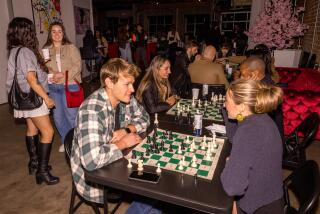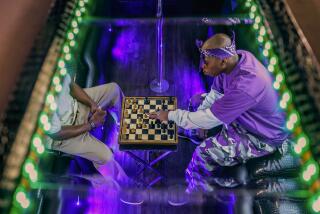ChessBrain No Pawn in Match With Human
- Share via
The kid had never been in a title bout.
In fact, ChessBrain was just 3 years old and had never gone one-on-one with a human being, let alone one of Denmark’s top players, ranked 53rd in the world.
But there they were on a snowy night in Copenhagen, eager to engage in battle.
The Jan. 30 chess match pitted Danish grandmaster Peter Heine Nielsen against the more than 2,000 computers of a loosely knit, global web called ChessBrain -- the all-consuming pastime of Thousand Oaks software engineer Carlos Justiniano. The dust-up, which ended in a draw, established a Guinness record for “the world’s largest networked chess computer.”
For Justiniano, 38, it was the stuff of legend: “This is the direction science fiction travels,” he said. “In the entire history of the planet, I’m not sure a collection of machines like this has collaborated to play a single game -- any kind of game -- against a human.”
Over thousands of hours, Justiniano, a prodigy who rose out of the south Bronx in New York, had devoted himself to ChessBrain like a monk to a medieval manuscript, tweaking computer programs and e-mailing far-flung collaborators well into the night.
As his wife and young daughter slept, he labored in the glow of nine computer screens, envisioning the day ChessBrain would hold its own in high-level competition.
“It’s been an incredible journey just to get to this point,” said Justiniano, who quit his job with a Torrance software company in December to prepare for the Denmark match.
“To lose without making a blunder was the best we had hoped for,” he said.
Computers that dabble in chess have been around since shortly after World War II, when scientists at Los Alamos National Laboratory started experimenting with massive electronic machines named ENIAC and MANIAC. In 1997, the most famous chess-playing automaton, IBM’s Deep Blue, decimated Garry Kasparov, then and now the world’s best human chess player, in a confrontation avidly followed around the globe.
ChessBrain, though, is not a single machine. It’s a “distributed-computing” system that depends totally on the kindness of strangers.
The concept is simple: Thousands of ordinary, desktop computers working together can do the same kind of hugely complex tasks as supercomputers. And they can do them silently, while their owners e-mail jokes to their pals or scan the Internet for old term papers.
Around the world, enthusiasts have downloaded a program from www.chessbrain.net that allows the network to use a tiny fraction of their computers’ excess processing power. That power enables ChessBrain to digest millions of moves from online chess games it has witnessed and games it has played against other chess engines.
Many of the people who volunteer their machines to the cause aren’t particularly interested in chess, Justiniano said. But they’re crazy about distributed computing -- one group calls itself the Dutch Power Cows -- and signs on for efforts to design new AIDS drugs, search for the largest prime number and scan the universe for other signs of life.
In Copenhagen, Justiniano and his colleagues were frantically scanning the city for cables, cords and adapters. Their luggage, containing their clothing and, more urgently, much of their equipment, had been lost. Justiniano had brought five laptop computers onto the plane but, with just a few days to gear up for the big match, other essential computers were missing.
“In the Scandinavian night, I was still wearing shorts,” said Cedric Griss, founder of the Distributed Computing Foundation, a Utah-based group that raised funds for the match. “We were bedraggled and tired. We were walking around, freezing. The Danish looked at us as if we were mad, and, in a way, I suppose we were.”
The gear was finally delivered and running. As a blizzard swirled outside, about 50 spectators sat expectantly in a Copenhagen science center. A few seconds after grandmaster Nielsen made his first move, they watched as the computer system collapsed.
“The network was struggling with the fact that thousands of computers were bombarding it all at once,” Justiniano said. “Its own peers were swamping it.”
In a separate room at the center, Justiniano went into overdrive, along with Colin Frayn, a 25-year-old British astrophysicist who developed ChessBrain’s software. The two had corresponded by e-mail for two years, but, until the night before the match, they had never spoken.
Forty-five minutes later, ChessBrain made its first move. It played without a hitch for nearly four hours, responding to each of Nielsen’s moves after conferring with 2,070 computers in 56 countries from Taiwan to Togo.
Nielsen was impressed. “It had good and bad moments, but so do grandmasters,” he said, noting that ChessBrain handily eluded various traps he’d set.
“At some point, I forced the draw,” he said. “Maybe I should have pushed harder.”
Sitting opposite Nielsen, Peter Wilson made ChessBrain’s moves after the network’s next move popped up on his computer screen. A former chairman of the World Chess Federation’s computer chess committee, Wilson said ChessBrain was different from most of the computers he’d seen in action.
“You can just look at their moves and know there’s a computer behind them,” said Wilson, who flew to the match from his home on the island of Guernsey in the English Channel. “Computer chess can be very cautious. It over-protects everything. Its moves can be quite ugly; they objectively may be the best, but they’re not appealing to a player at the grandmaster level.”
Despite some flaws, ChessBrain “played certain surprises,” Wilson said. “They were rather more the type of plays that I think humans would make.”
After 34 moves, Nielsen and ChessBrain agreed that neither could win and declared a draw -- the anticlimactic ending to about half of all top-level matches.
For Justiniano, who is back in Thousand Oaks looking for a job, a draw was the sweetest of victories. “It’s one thing to be looked at as a crackpot and another to come back and say: ‘Well, it’s done,’ ” he said.
Besides, in chess as in baseball, there’s always next year. A rematch is planned for 2005.







